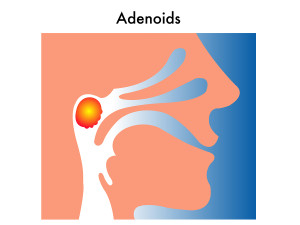The adenoids are also known as “pharyngeal tonsils”.
The tissue close to the eustachian tube entrance on each side in the upper pharynx area just behind the inner nose can grow so big that it looks like a tonsil in the wrong place. You can see a picture of enlarged adenoids here.(thanks to www.ghorayeb.com for this link).
Symptoms
Patients with enlarged adenoids have a characteristic facial expression with an open mouth (mouth breathers), a nasal speech, they often suffer from recurrent middle ear infections (otitis media) or persistent serous otitis.
Children with enlargement of the adenoids (adenoid hypertrophy) may be chronically tired, breathe through their open mouth during their sleep and often snore. They may also have a chronic cough, particularly at night as the airways dry out from mouth breathing and pus can drip into the airways and cause choking. Hearing loss from chronic serous otitis often requires ear tubes to be put in. It is often at this occasion that the ENT specialist sees the adenoids, makes the diagnosis and recommends surgery for this.
Diagnostic test
The enlarged adenoids can be felt with the examining finger in a smaller child. With cooperation in an older child the specialist uses a pharyngeal mirror or the fiberoptic instrument, called nasopharyngoscope. With an uncooperative child it may be necessary to do soft tissue X-rays of the nasopharynx instead to show the nasopharyngeal airway obstruction by the enlarged adenoids.
Treatment
Adenoidectomy is the name for the surgical removal of the hypertrophied adenoids. In a child older than 3 years it is an outpatient procedure. Smaller children are usually kept in the hospital overnight (Ref.2, p. 1268).
References:
1. James Chin et al., Editors: Control of Communicable Diseases Manual, 17th edition, 2000, American Public Health Association.
2. Behrman: Nelson Textbook of Pediatrics, 16th ed., 2000, W. B. Saunders Company
3. J M Hickner et al. Ann Emerg Med 37(6): 703-710. June 2001.
4. Noble: Textbook of Primary Care Medicine, 3rd ed.,2001 Mosby, Inc.
5. Abeloff: Clinical Oncology, 2nd ed.,2000,Churchill Livingstone, Inc.
6. Ferri: Ferri’s Clinical Advisor: Instant Diagnosis and Treatment, 2004 ed., Copyright © 2004 Mosby, Inc.
7. Rakel: Conn’s Current Therapy 2004, 56th ed., Copyright © 2004 Elsevier







